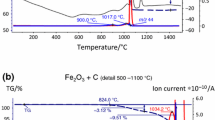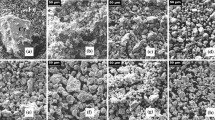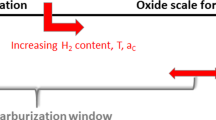Abstract
Successful removal of the surface oxides, present on the powder particle surface, during initial stages of sintering is the prerequisite for the development of strong inter-particle necks and so high mechanical performance of the sintered PM components. In the case of water-atomized powder prealloyed with chromium, surface oxide is composed of an iron oxide layer, covering about 90–95 % of the powder surface, with some presence of more stable fine particulate oxides. Sufficiently strong inter-particle necks require as minimum full removal of the iron surface oxide layer. This can be achieved by a number of gaseous reducing agents (H2, CO, or mixture of both) as well as by carbon typically admixed in the form of graphite. The present study is focused on the analysis of the reducing ability of the different sintering atmospheres (concentration of active gasses ≤10 vol%) as well as vacuum and their combined effect with graphite by means of thermal analysis. Number of effect characteristic for Cr-alloyed PM steels and their extent in different atmospheres were identified, namely risk of Cr-loss during sintering in high vacuum, risk of oxidation in CO-containing atmospheres, and nitrogen pickup, etc. When it comes to the oxidation/reduction processes, results indicate that the combination of the dry hydrogen-containing atmospheres and fine graphite grades allows successful sintering of chromium alloyed PM steels.









Similar content being viewed by others
References
Höganäs AB. Höganäs handbook for sintered components. Höganäs; 2004.
Karlsson H, Nyborg L, Berg S. Surface chemical analysis of prealloyed water-atomised steel powder. Powder Metall. 2005;48:51–8.
Chasoglou D, Hryha E, Norell M, Nyborg L. Characterization of surface oxides on water-atomized steel powder by XPS/AES depth profiling and nano-scale lateral surface analysis. Appl Surf Sci. 2013;268:06–496.
Hryha E, Gierl C, Nyborg L, Danninger H, Dudrova E. Surface composition of the steel powders pre-alloyed with manganese. Appl Surf Sci. 2010;256:3946–61.
Hryha E, Nyborg L. Oxide transformation during sintering of prealloyed water atomized steel powder. Proc World PM. 2010;2010(2):268–75.
Hryha E, Nyborg L. Effect of processing parameters on oxide transformation in Cr-Mn-prealloyed sintered steels. Proc World PM 2012. 2013:16A-T9-12 (CD-ROM).
Chasoglou D, Hryha E, Nyborg L. Effect of process parameters on surface oxides on chromium-alloyed steel powder during sintering. Mater Chem Phys. 2013;138:405–15.
Hryha E, Dudrova E, Nyborg L. On-line control of processing atmospheres for proper sintering of oxidation-sensitive PM steels. J Mater Proc Technol. 2012;212:977–87.
Hryha E, Nyborg L, Malas A, Wiberg S, Berg S. Carbon control in PM sintering: industrial applications and experience. Powder Metall. 2013;56:5–10.
Ortiz P, Castro F. Thermodynamic and experimental study of role of sintering atmospheres and graphite additions on oxide reduction in Astalloy CrM powder compacts. Powder Metall. 2004;47:291–8.
Danninger H, Gierl C, Kremel S, Leitner G, Jaenicke-Roessler K, Yu Y. Degassing and deoxidation processes during sintering of unalloyed and alloyed PM steels. Powder Metall Prog. 2002;2:125–39.
Bergman O, Frisk K, Nyborg L. Analysis of oxide reduction during sintering of Cr-alloyed steel powder through photoacoustic spectroscopy measurements. Proc EURO PM. 2009;2009(3):239–44.
Hryha E, Čajková L, Dudrová E. Study of reduction/oxidation processes in Cr–Mo prealloyed steels during sintering by continuous atmosphere monitoring. Powder Metall Prog. 2007;7:181–97.
Hebda M, Gadek S, Skalon M, Kazior J. Effect of mechanical alloying and annealing on the sintering behaviour of AstaloyCrL powders with SiC and carbon addition. J Therm Anal Calorim. 2013;113:03–395.
Hebda M, Gadek S, Kazior J. Thermal characteristics and analysis of pyrolysis effects during the mechanical alloying process of Astaloy CrM powders. J Therm Anal Calorim. 2012;108:453–60.
Hryha E, Nyborg L. Effectiveness of different reducing agents during sintering of Cr-prealloyed PM steels. Proc Euro PM2013. 2013;2:333–8.
Dlapka M, Gierl C, Danninger H, Bengtsson S, Dudrova E. Nitrogen pickup during sintering and subsequent cooling of chromium alloyed PM steels. Proc World PM. 2010;2010(2):563–71.
Bergman O. Effect of nitrogen uptake during sintering on the properties of PM steels prealloyed with chromium. Proc Euro PM. 2001;2001(1):64–9.
Danninger H, Gierl C, Vassileva V, Liersch A, Kalss G. Reaction of nitrogen atmospheres with PM steel compacts during sintering. Proc World PM. 2008;2008(5):563–71.
Acknowledgements
Support from the Sustainable Production Initiative of Chalmers Area of Advance in Production is gratefully acknowledged. Further thanks are also extended to Sigurd Berg and Prof. Sven Bengtsson, Höganäs AB, for scientific cooperation and specimens supply.
Author information
Authors and Affiliations
Corresponding author
Rights and permissions
About this article
Cite this article
Hryha, E., Nyborg, L. Thermogravimetry study of the effectiveness of different reducing agents during sintering of Cr-prealloyed PM steels. J Therm Anal Calorim 118, 825–834 (2014). https://doi.org/10.1007/s10973-014-3915-z
Received:
Accepted:
Published:
Issue Date:
DOI: https://doi.org/10.1007/s10973-014-3915-z




